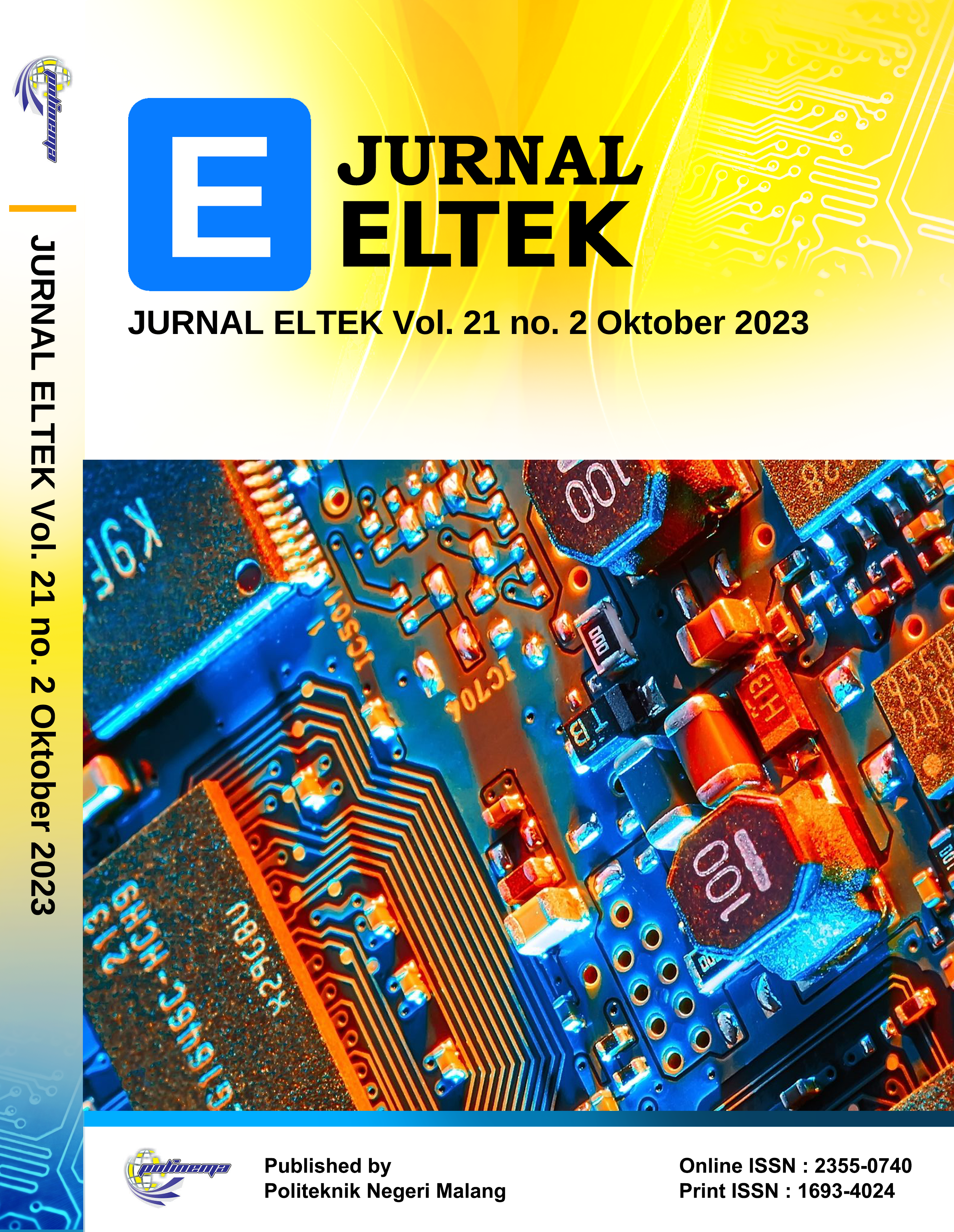Sintesis Dan Karakterisasi Material Katoda LiMn0,7Fe0,3-xNixPO4/C Dengan 0 ≤ X ≤ 0,2 Dalam Aplikasi Baterai Litium-Ion
DOI:
https://doi.org/10.33795/eltek.v21i2.4393Keywords:
Konduktifitas Elektronik dan Ionik, Pati Singkong, Specific Capacity, Struktur Olivin LiMnPO4, Subtitusi Kation Fe dan NiAbstract
Pati singkong sebagai karbon pelapis bahan aktif LiMnPO4, Fe dan Ni (covalent-doping) ditempuh untuk meningkatkan konduktifitas elektronik-ionik, nilai specific capacity dan working voltage. Proses solid state reaction berupa ball milling (330 rpm, 48 jam) dan sintering (800°C, 2 jam) digunakan dalam pembuatan bahan aktif. Pola difraksi LiMnPO4 terlihat pada uji XRD pada bahan aktif. Bahan aktif terlapisi karbon berukuran 290 nm dan ukuran kristalit 60 nm terbentuk melalui proses Ball Milling. Pengujian SEM memperlihatkan pertumbuhan pelapisan karbon kearah horizontal dan pengujian EDX menunjukkan kadar Mn yang tinggi mengkonfirmasi peran pati singkong sebagai fasilitator pengintian pelapisan karbon. Nilai vibrasi v1 - v4 (1138 dan 1098 cm-1) hasil pengujian FTIR menunjukkan polianion terbentuk. Pelapisan karbon memberikan nilai konduktifitas elektronik-ionik sebesar 1 x 10-3 S/cm dan 7,2 S/cm, peningkatan nilai konduktifitas elektronik terjadi akibat penambahan Ni. LiMn0,7Fe0,25Ni0,05PO4/C memberikan nilai specific capacity oksidasi 60,92 mAh/gr dan nilai Voks-red sekitar 4,13 Volt dan secara praktikal dapat digunakan sebagai bahan aktif katoda baterai Li-Ion.
ABSTRACT
Carbon-coating process with starch of cassava in LiMnPO4 active material, co-subtitution by adding Fe and Ni have been used to enhance ionic-electronic conductivity, specific capacity, and working voltage. Pattern diffraction of XRD shown LiMnPO4 structure have been formed via milling process (330 rpm, 48 hours) and sintering process (800°C, 2 hours) as called as solid state reaction. Ball Milling produced active material with the particle size and crystallite size up to 290 nm and 60 nm respectively. Carbon-coating have been grown in horizontal direction in cathode material become an evidence that the starch of cassava have been facilitates nuclea of carbon-coating to grown in cathode material and can be seen by SEM, and also the high content of Mn that have founded by EDX evaluation agreed. Polyanion have formed and indicated by vibration value of v1 - v4 (1138 and 1098 cm-1) during FTIR evaluation. Electronic conductivity increased up to 1 x 10-3 S/cm by carbon-adding process, and Ni-addition as cation-doping contributed also. LiMn0.7Fe0,25Ni0.05PO4/C of cathode material shown the highest specific capacity oxidation near 60.92 mAh/gr and Voxidation/reduction around 4.13 Volts and practically can be used as Li-Ion battery.
References
D. Linden, dan T.B. Reddy, Handbook Of Batteries (3rd ed.), New York, USA : McGraw-Hill, 2002.
C. Cluzel, dan C. Douglas, “Cost and performance of EV batteries (final report for the committee on climate change)”, Cambridge, UK : Element Energy Limited, 2012.
Y. S. Meng, B. Xu, D. Qian, and Z. Wang, “Recent progress in cathode materials research for advanced lithium ion batteries”, Material Science and Engineering, R73 : 51-65, 2012.
A. Yamada, M. Hosoya, S. Chung, Y. Kudo, K. Hinokuma, K. Liu, and Y. Nishi, “Olivine-type cathodes: achievements and problems”, Journal of Power Sources, 119-121 : 232-238, 2003.
J. Yang, F. Wang, P. Gao, Y. NuLi, and J. Wang, “Short communication: morphology regulation and carbon coating of LiMnPO4 cathode material for enhanced electrochemical performance”, Journal of Power Sources, 196 : 10258-10262, 2011.
M. Wakihara, “Recent developments in lithium ion batteries”, Materials Science and Engineering, R33 : 109-134, 2001.
D. Guibert, “Innovation in industrial technologies: The case of batteries”, SAFT Presentation, 2012.
J. Wang, and X. Sun, “Olivine LiFePO4: the remaining challenges for future energy storage”. Energy & Environmental Science, 8(4), 1110–1138, doi:10.1039/c4ee04016c, 2015.
H. Fang, E. Dai, B. Yang, Y. Yao, and W. Ma, “Short communication: LiMn0.8Fe0.19Mg0.01PO4/C as a high performance cathode material for lithium ion batteries”, Journal of Power Sources, 204 : 193-196, 2012.
J. Graetz, J. Hong, F. Wang, and X. Wang, “LiFexMn1-xPO4: a cathode for lithium-ion batteries”, Journal of Power Sources, 196 : 3659-3663, 2011.
X. Huang, B. Zhang, H. Li, and X. Wang, ”Electrochemical performances of LiFe1-xMnxPO4 with high Mn content”, Journal of Power Sources, 196 : 6992-6996, 2011.
C. Suryanarayana, and G. M. Norton, G. M, X-Ray Diffraction A Practical Approach, New York, US : Plenum Press, 1998.
J. Molenda, W. Ojczyk, and J. Marzec, “Electrical conductivity and reaction with lithium of LiFe1-yCMnyPO4 olivine-type cathode materials”, Journal of Power Sources, 174 : 689-694, 2007.
Y. L. Wang, J. Li, F. Wu, K. Liang, R. Zhang, H. Xu, Y. Wan, Y. Y. Dai, “Synthesis mechanism and characterization of LiMn0.5Fe0.5PO4/C composite cathode material for lithium-ion batteries”, Journal of Alloys and Compounds, doi: https://doi.org/10.1016/ j.jallcom.2020.155653, 2020.
M. Takahashi, S. Tobishima, K. Takei, and Y. Sakurai, “Reaction behaviour of LiFePO4 as a cathode material for rechargeable lithium batteries”, Solid State Ionics, 148 : 283-289, 2002.
S. Geller, and J. L. Durand, “Refinement of the structure of LiMnPO4 locality: synthetic”. Acta Crystallographica, 13 : 325-331, 1960.
J. Triwibowo, “Rekayasa bahan LixTiMnyFez(PO4)3 sebagai katoda solid polymer battery (SPB) lithium”, Tesis Master, Teknik Metalurgi dan Material, Universitas Indonesia, Kota Depok, Indonesia, 2011.
A. M. Sastry, M. Park, X. Zhang, M. Chung, and G. B. Less, “A review of conduction phenomena in li- ion batteries”, Journal of Power Sources, 195 : 7904-7929, 2010.
Downloads
Published
How to Cite
Issue
Section
License
Copyright (c) 2023 Rudiyansah, Anne Zulfia S, Bambang Prihandoko

This work is licensed under a Creative Commons Attribution-ShareAlike 4.0 International License.







